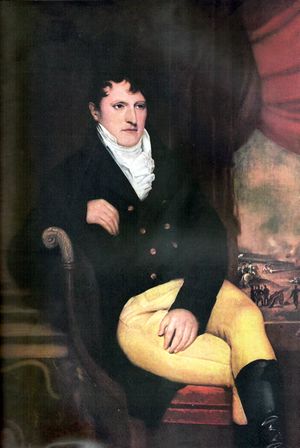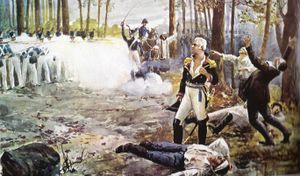خوان خوسيه كاستلي
| خوان خوسيه كاستلي Juan José Castelli | |
|---|---|

| |
| Committee member of the Primera Junta | |
| في المنصب May 25, 1810 – June 9, 1811 تخدم مع Manuel Alberti, Miguel de Azcuénaga, Manuel Belgrano, Domingo Matheu, Juan Larrea | |
| تفاصيل شخصية | |
| وُلِد | July 19, 1764 Buenos Aires, Viceroyalty of Peru |
| توفي | أكتوبر 12, 1812 (aged 48) Buenos Aires, United Provinces of the Río de la Plata |
| المدفن | San Ignacio Church |
| القومية | Argentine |
| الحزب | Carlotism, Patriot |
| الزوج | María Rosa Lynch |
| الجامعة الأم | University of Chuquisaca |
| المهنة | Lawyer |
| الدين | Catholic |
| التوقيع | 
|
| الخدمة العسكرية | |
| الولاء | |
| سنوات الخدمة | 1810–1811 |
| قاد | Army of the North |
| المعارك/الحروب | First Upper Peru campaign |
خوان خوسيه كاستلي Juan José Castelli (19 يوليو 1764 – 12 أكتوبر 1812) كان محامياً أرجنتينياً. وكان أحد قادة ثورة مايو، التي بدأت حرب الاستقلال الأرجنتينية. وقد قاد الحملة العسكرية المشئومة في پيرو العليا.
Juan José Castelli was born in Buenos Aires, and went to school at the Real Colegio de San Carlos in Buenos Aires and Monserrat College in the city of Córdoba, Argentina. He graduated as a lawyer from the University of Charcas, in Upper Peru. His cousin, Manuel Belgrano, introduced him to the public administration of the Viceroyalty of the Rio de la Plata. Along with Belgrano, Nicolás Rodríguez Peña, and Hipólito Vieytes, Castelli planned a revolution to replace the absolute monarchy with the new ideas of the Age of Enlightenment. He led the Buenos Aires patriots during the May Revolution, which ended with the removal of viceroy Baltasar Hidalgo de Cisneros from power. He is known as the "Speaker of the Revolution" for his speech during the open cabildo held in Buenos Aires on May 22, 1810.
Castelli was appointed a Committee member of the Primera Junta and was sent to Córdoba to end Santiago de Liniers's counter-revolution. He succeeded, and ordered the execution of Liniers and his supporters. He then commanded the establishment of a revolutionary government in Upper Peru (today's Bolivia) with the aim of freeing the indigenous peoples and African slaves. In 1811 Castelli signed a truce with the Spanish in Upper Peru, but they betrayed him and caught the Northern Army unprepared. As a result, the Argentines suffered a major loss in the Battle of Huaqui on June 20, 1811. When Castelli returned to Buenos Aires, the First Triumvirate imprisoned him for losing the battle, and Castelli died shortly afterwards from tongue cancer.
. . . . . . . . . . . . . . . . . . . . . . . . . . . . . . . . . . . . . . . . . . . . . . . . . . . . . . . . . . . . . . . . . . . . . . . . . . . . . . . . . . . . . . . . . . . . . . . . . . . . . . . . . . . . . . . . . . . . . . . . . . . . . . . . . . . . . . . . . . . . . . . . . . . . . . . . . . . . . . . . . . . . . . . .
سيرته
First political steps

The British invasions
Rodriguez Peña introduced Castelli to James Florence Burke, who claimed to represent the British Empire in support of proposals published by Francisco de Miranda, which aimed to emancipate the Latin American colonies. Burke was actually a British spy, gathering information about the Spanish colonies. Bearing promises of British support, he created the first native secret society organized for such purposes. It would henceforth be known as "party of independence", and included Castelli, Burke and major contributors of Vieytes's newspaper. The spy was eventually discovered by Viceroy Rafael de Sobremonte and expelled from the viceroyalty, but his duplicity was not disclosed to his unaware associates.[1]
Carlotism

Napoleon invaded Spain in 1807, starting the Peninsular War. King Charles IV of Spain abdicated in favor of his son Ferdinand VII, but Napoleon captured him and appointed his own brother, Joseph Bonaparte, as king of Spain instead, in a series of transfers of the Spanish crown known as the abdications of Bayonne. The Spanish people organized Government Juntas to resist against the French occupation, and within months the Junta Central of Seville claimed supreme authority over Spain and the colonies. This situation encouraged the Princess Charlotte of Spain to claim the regency of the Spanish American colonies.[2]
ثورة مايو

Execution of Liniers

Campaign in Upper Peru

The Battle of Huaqui
Legacy
Castelli is largely ignored in the historiography of Argentina. Most historians focus instead on the disputes between Mariano Moreno and Cornelio Saavedra in the Junta, with Castelli described in passing as a supporter of Moreno.[3] Despite of his role in the May Revolution, he was not the clear leader of it, as José Gervasio Artigas was for the Cry of Asencio or Miguel Hidalgo y Costilla for the Cry of Dolores. The May Revolution was instead the result of the convergence of diverse factions that shared the desire to remove the viceroy, and different historians highlight different specific factions.[4] Castelli is largely ignored in Bolivia as well. His support of indigenous rights—still an ongoing issue in the country—and his religious ideas strongly affect the way he is perceived there.[5]
The most notable biography of Castelli was Castelli, el adalid de Mayo (إسپانية: Castelli, the champion of May), written by the Paraguayan Julio César Chaves. Andrés Rivera increased the public awareness about Castelli with the historical novel La revolución es un sueño eterno (إسپانية: The revolution is an eternal dream). The famous divulgator Felipe Pigna wrote a whole chapter about Castelli at the book Los mitos de la historia argentina, which was then moved to television in the documentary film Algo habrán hecho por la historia argentina.[5]
المراجع
Bibliography
- Gelman, Jorge; Raúl Fradkin (2010). Doscientos años pensando la Revolución de Mayo. Buenos Aires: Sudamericana. ISBN 978-950-07-3179-9.
- Luna, Félix (2001). Grandes protagonistas de la Historia Argentina: Juan José Castelli (in Spanish). Buenos Aires: Grupo Editorial Planeta. ISBN 950-49-0656-7.
{{cite book}}: CS1 maint: unrecognized language (link) - Luna, Félix (2004). "El contrabando, una singular forma de comercio en las colonias". Grandes protagonistas de la Historia Argentina: Manuel Belgrano (in Spanish). Buenos Aires: Grupo Editorial Planeta. ISBN 950-49-1247-8.
{{cite book}}: CS1 maint: unrecognized language (link) - Galasso, Norberto (2004). Mariano Moreno, "El sabiecito del sur" (in Spanish). Buenos Aires, Argentina: Colihue. ISBN 950-581-799-1.
{{cite book}}: CS1 maint: unrecognized language (link) - Alberto Lapolla (06/05/2008). "El héroe maldito: Juan José Castelli" [The cursed hero: Juan José Castelli]. El Sol del 25 viene asomando, apuntes para repensar Mayo (in Spanish). Avizora. Retrieved October 28, 2011.
{{cite web}}: Check date values in:|date=(help)CS1 maint: unrecognized language (link) - National Academy of History of Argentina (2010). Revolución en el Plata (in Spanish). Buenos Aires: Emece. ISBN 978-950-04-3258-0.
{{cite book}}: CS1 maint: unrecognized language (link) - Scenna, Miguel Ángel (2009). Mariano Moreno (in Spanish). Buenos Aires: H. Garetto Editor. ISBN 978-987-1494-05-4.
{{cite book}}: CS1 maint: unrecognized language (link)
. . . . . . . . . . . . . . . . . . . . . . . . . . . . . . . . . . . . . . . . . . . . . . . . . . . . . . . . . . . . . . . . . . . . . . . . . . . . . . . . . . . . . . . . . . . . . . . . . . . . . . . . . . . . . . . . . . . . . . . . . . . . . . . . . . . . . . . . . . . . . . . . . . . . . . . . . . . . . . . . . . . . . . . .
وصلات خارجية
- Biography at Argentina.ar (بالإسپانية)
- Biography at El Historiador (بالإسپانية)
- Articles with hatnote templates targeting a nonexistent page
- Articles containing إسپانية-language text
- Pages using Lang-xx templates
- Members of the Primera Junta
- Argentine abolitionists
- Argentine people of Italian descent
- Argentine people of Venetian descent
- University of Saint Francis Xavier alumni
- Deaths from oral cancer
- Deaths from cancer in Argentina
- Politicians from Buenos Aires
- 1764 births
- 1812 deaths
- People of the Argentine War of Independence
- Argentine lawyers
- Prisoners and detainees of Argentina
- خريجو جامعة شلمنقة

